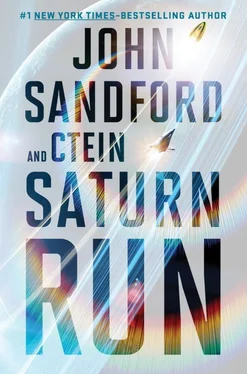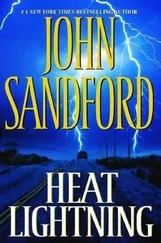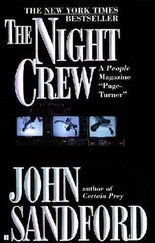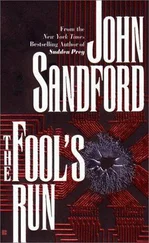BECCA:Sure, the Chinese are using a nuclear thermal rocket. Take a nuclear fission reactor, get it real hot, and pump hydrogen through it. The hydrogen heats up and jets out the back, and there’s your rocket engine. The only difference between their engine and a chemical rocket is that they’re heating the gas in a fission reactor instead of by combustion.
FLORA:Okay, and the U.S. mission is using…?
BECCA:An engine that’s never been used on a major space mission before, called a “va-si-meer”…
FLORA:You better spell that.
BECCA:V-A-S-I-M-R, which stands for “Variable Specific Impulse Magnetoplasma Rocket.”
FLORA:Oh, well, that clears everything up!
BECCA:[laughter] Well, then, my work here is done. Okay, before everyone tunes out…
FLORA:It may be too late for that [more laughter]…
BECCA:What we have is a really big, fancy kind of ion engine. We take a gas and ionize it—knock an electron or two off of each atom so instead of being electrically neutral, each atom has a positive charge. We funnel those ions into a big particle gun. It uses magnetic and electric fields to grab those ions and accelerate them to very high velocities. We squirt them out the back, and there’s your rocket exhaust.
FLORA:So where does the reactor come in?
BECCA:Reactors, actually. We have two. That way in case something goes wrong with one, the Nixon isn’t dead in space. The reactors come in because our rocket engine uses electricity. It takes electric power to ionize the gas and it takes electric power to generate the magnetic and electric fields that accelerate the ions. We use the reactors to power an electric plant, just as we would on Earth.
FLORA:Then, the ship’s power plant is a lot like the systems you’re used to designing for electric utility companies?
BECCA:Yes, which is why they want my expertise. But there are some important differences. The ship’s power plant is considerably bigger than any reactor complex in commercial use. It puts out nineteen gigawatts of thermal power. That’s an awful lot of power in a small space, and make no mistake, it is a small space. The reactors themselves wouldn’t fill up this room.
FLORA:Wow. Why are reactors in regular power plants so much larger?
BECCA:Partly because they don’t have to be any smaller. It’s a lot harder to manage that kind of power in a small volume than a large one. Also, the reactor on Earth is surrounded by tons and tons of shielding and containment vessels to protect people and the environment from its contents. In our spaceship, we dispense with most of that. The reactors are all the way at one end of the ship and just need a small shielding cap to provide a radiation shadow for the occupied portions of the ship. We don’t need a big, bulky containment vessel. If something goes wrong and the reactor fails catastrophically, that’s gonna be the end of us, anyway. My job, along with the reactor designers, is to make sure that won’t happen.
FLORA:Okay, then, what makes a VASIMR better than a tried-and-true nuclear thermal rocket?
BECCA:Two things—the first is that we can get a much higher exhaust velocity out of the VASIMR. That means we can go a lot faster using the same amount of reaction mass. I think I can explain how that works to your listeners.
FLORA:I certainly hope so.
BECCA:Imagine you’re on a pair of roller skates and you’re holding a bowling ball. If you throw the bowling ball away from you, you start rolling backwards. Action balances reaction, thank you, Newton. Now suppose instead of a bowling ball, you have a small pistol that you fire. What happens? The bullet goes forward and the recoil sends you rolling backwards. A very small mass, like that bullet, can push you just as hard as the bowling ball did, if it’s going very fast. The VASIMR gives us a lot more push than a nuclear thermal rocket would, for the same amount of reaction mass.
FLORA:And the second thing?
BECCA:This part’s a bit peculiar. The way rocket physics works, it takes a lot more energy to get the ship up to speed with a high-velocity exhaust than with low velocity. Our fast-moving ions are very efficient at using a small amount of reaction mass but very inefficient at using small amounts of energy.
To put it another way, if we want to use as little reaction mass as we can, we want to throw bullets. But if we want to get the most speed from our power plant, we want bowling balls.
In between those extremes is a happy medium. If we adjust the exhaust velocity as we go, we can get by with a ship that’s about half as big as it would be with a fixed exhaust velocity. Rocket scientists call the exhaust velocity “specific impulse,” which is where the first three words of the engine’s name come from: “variable specific impulse.”
FLORA:On to my next question. If VASIMRs are better than thermal nuclear rockets, why didn’t the Chinese use them in their ship?
BECCA:VASIMRs have one big disadvantage—they’re electric. A nuclear thermal rocket puts all its heat energy into the exhaust, it’s essentially one hundred percent efficient. We have to convert the heat of the reactor into electricity and using every trick we know, we can only do that with fifty-five to sixty percent efficiency. The other forty-odd percent? It’s waste heat, and if we don’t get rid of it the ship’ll fry. To give you an idea how much heat I have to deal with, it’s as if you took all the power used by a city the size of, say, Minneapolis, and stuffed it inside our little bitty rocket. My job is to get rid of it!
Believe me, that’s not easy. There’s a lot of specialized plumbing, some humongous heat radiators, the whole thing is very complicated. Our early tests… well… we had some hiccups.
FLORA:That radiator test in orbit last January?
BECCA:Ummm, yeah, that didn’t go so well. But cutting-edge engineering is like that. That’s why we test instead of just flying off. Anyway, a gas core reactor with a hydrogen flow-through, like the Chinese use, is child’s play compared to this. That’s a lot more stable and we have a lot more experience with it. If we didn’t need to be going really, really fast, we’d never be using VASIMRs. The Chinese were originally going to Mars. They didn’t need to be going anywhere that fast. A simple nuclear thermal rocket would get them there in a few months with a very reasonable mass-to-payload ratio. To get that same ship to Saturn, though, they had to hot-rod the whole setup, add some truly monstrous hydrogen tanks for the additional reaction mass they need, and it’s still going to take them a year and a half to get there. They are the tortoise and we’re the hare. This time, though, the hare is going to win the race.
FLORA:Thank you very much for your time, Becca.
As the Nixon passed the moon’s orbit, it officially entered interplanetary space. The ship was finally starting to show what it was made for. By interplanetary standards, its velocity was still modest, at six kilometers per second relative to Earth, but now the Nixon was essentially free of Earth’s gravity. The thrust of the VASIMRs produced a small but steady acceleration that piled another four kilometers per second onto the ship’s velocity each and every day. It had taken about sixty hours to pass lunar orbit, but another sixty would see the Nixon some two million kilometers from Earth.
Читать дальше








